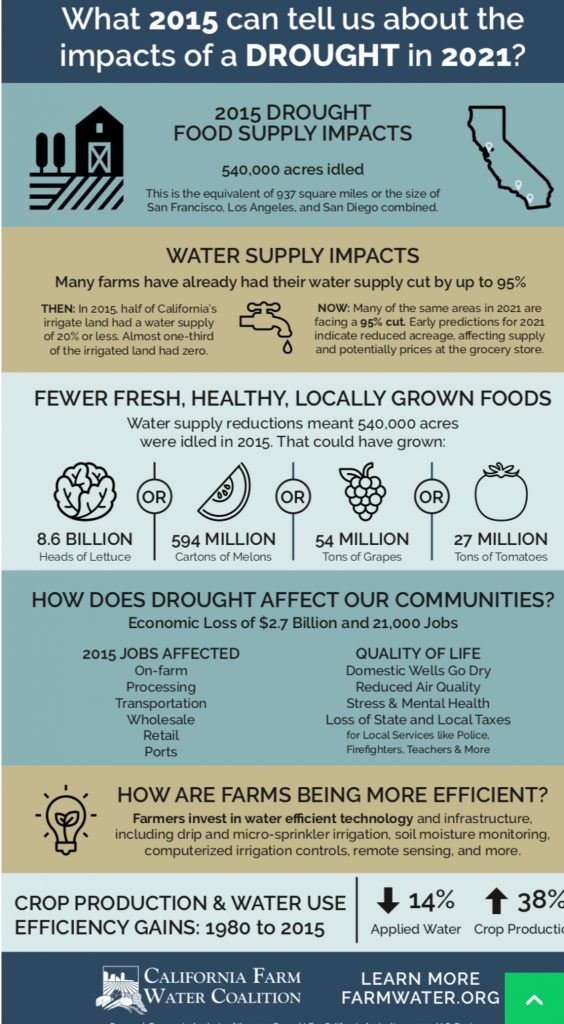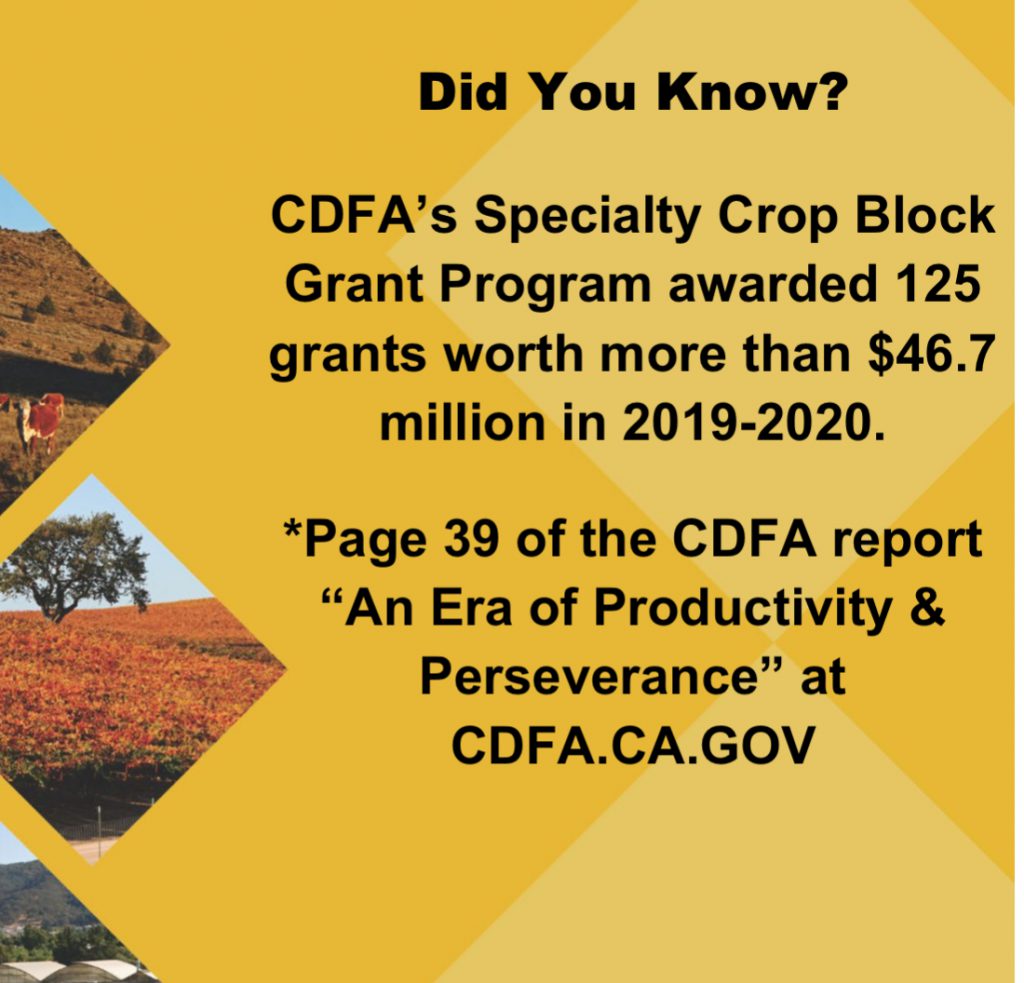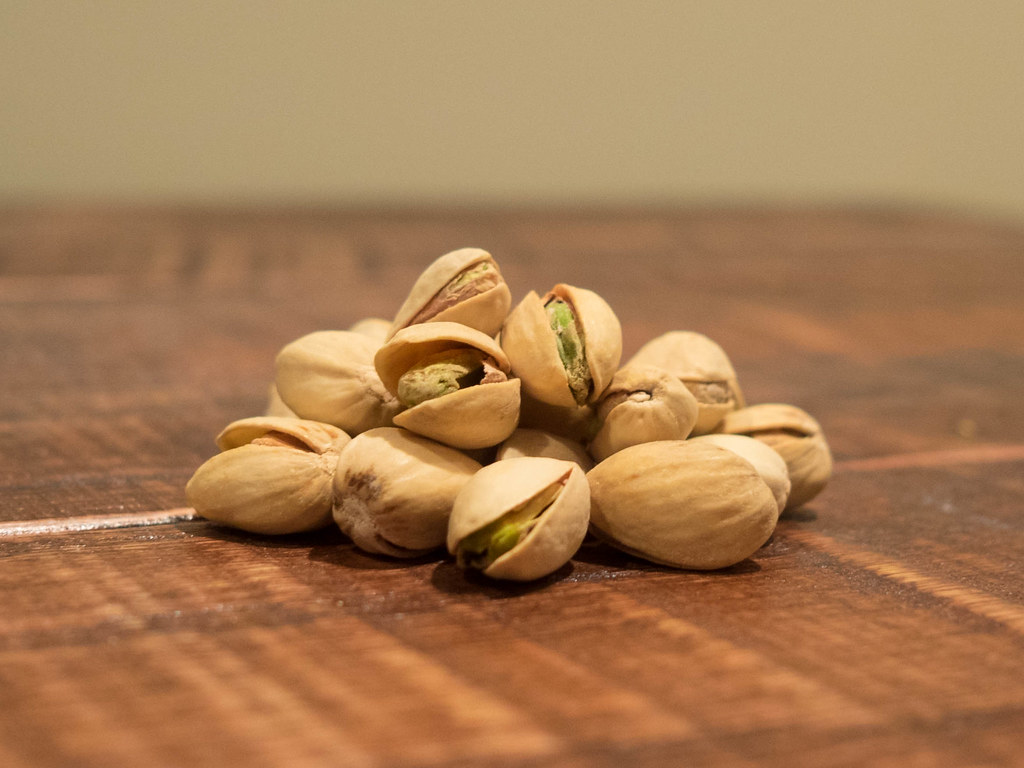-
Recent Posts
- The Climate Resilience Strategy for California Agriculture is out for public review
- Agritourism – California’s Pumpkin Patches: Hunter Farms
- CDFA Undersecretary Christine Birdsong counts down California CRUNCH!
- Celebrating Hispanic Heritage Month – California Farmer Mel Resendiz
- Secretary Ross on Water, Workforce, and the Future of California Agriculture — from AgNet West
Recent Comments
- CA agriculture value surpasses $60B | Western Livestock Journal on Value of California Ag production tops $60 billion for first time
- Kathy de Contreras on CDFA IT department honored at “Best of California” awards
- El costo económico de las deportaciones masivas ya es visible en California - Espanol News on Nine California Counties Make Top-10 List for Ag Sales in the U.S.
- Deportations are taking a toll on California’s economy – and have only just begun – The News Beyond Detroit on Nine California Counties Make Top-10 List for Ag Sales in the U.S.
- Kenneth Cooper McNany on California Agricultural Heritage Club seeks nominations to honor pioneering farms and ranches more than 100 years old
Archives
- October 2025
- September 2025
- August 2025
- July 2025
- June 2025
- May 2025
- April 2025
- March 2025
- February 2025
- January 2025
- December 2024
- November 2024
- October 2024
- September 2024
- August 2024
- July 2024
- June 2024
- May 2024
- April 2024
- March 2024
- February 2024
- January 2024
- December 2023
- November 2023
- October 2023
- September 2023
- August 2023
- July 2023
- June 2023
- May 2023
- April 2023
- March 2023
- February 2023
- January 2023
- December 2022
- November 2022
- October 2022
- September 2022
- August 2022
- July 2022
- June 2022
- May 2022
- April 2022
- March 2022
- February 2022
- January 2022
- December 2021
- November 2021
- October 2021
- September 2021
- August 2021
- July 2021
- June 2021
- May 2021
- April 2021
- March 2021
- February 2021
- January 2021
- December 2020
- November 2020
- October 2020
- September 2020
- August 2020
- July 2020
- June 2020
- May 2020
- April 2020
- March 2020
- February 2020
- January 2020
- December 2019
- November 2019
- October 2019
- September 2019
- August 2019
- July 2019
- June 2019
- May 2019
- April 2019
- March 2019
- February 2019
- January 2019
- December 2018
- November 2018
- October 2018
- September 2018
- August 2018
- July 2018
- June 2018
- May 2018
- April 2018
- March 2018
- February 2018
- January 2018
- December 2017
- November 2017
- October 2017
- September 2017
- August 2017
- July 2017
- June 2017
- May 2017
- April 2017
- March 2017
- February 2017
- January 2017
- December 2016
- November 2016
- October 2016
- September 2016
- August 2016
- July 2016
- June 2016
- May 2016
- April 2016
- March 2016
- February 2016
- January 2016
- December 2015
- November 2015
- October 2015
- September 2015
- August 2015
- July 2015
- June 2015
- May 2015
- April 2015
- March 2015
- February 2015
- January 2015
- December 2014
- November 2014
- October 2014
- September 2014
- August 2014
- July 2014
- June 2014
- May 2014
- April 2014
- March 2014
- February 2014
- January 2014
- December 2013
- November 2013
- October 2013
- September 2013
- August 2013
- July 2013
- June 2013
- May 2013
- April 2013
- March 2013
- February 2013
- January 2013
- December 2012
- November 2012
- October 2012
- September 2012
- August 2012
- July 2012
- June 2012
- May 2012
- April 2012
- March 2012
- February 2012
- January 2012
- December 2011
- November 2011
- October 2011
- September 2011
- August 2011
- July 2011
- June 2011
Categories
- AG Vision
- Agricultural Education
- Agricultural Marketing
- Alternative Fuels
- Animal health
- Animal Welfare
- Asian Citrus Psyllid
- Biodiversity
- Border stations
- BSE
- Cannabis
- Cannella Panel
- Climate Change
- Climate Smart Agriculture
- Community-based Food System
- Conservation
- Dairy
- Drought
- Environment
- Fairs
- Farm Bill
- Farm Labor
- Farmers' Markets
- Fertilizer
- Food Access
- Food Safety
- Food Waste
- Glassy-winged Sharpshooter
- Growing California
- Healthy soils
- HLB
- Hydrogen
- Integrated Pest Management (IPM)
- Invasive Species
- Light Brown Apple Moth
- Livestock ID
- Measurement Standards
- Nutrition
- Organic agriculture
- Pierce's Disease
- Pollinators
- Specialty Crops
- State Board of Food and Agriculture
- Succession Planning
- Trade
- Uncategorized
Pages

As dry conditions persist, drought impacts in 2015 provide insights — from the California Farm Water Coalition
Posted in Uncategorized
Leave a comment
Pistachios bring more than $5 billion in economic impact — from Western Farm Press
By Todd Fichette
Pistachios farmed in California, Arizona and New Mexico infused nearly $5.3 billion of combined economic activity across the region, according to a report commissioned by the American Pistachio Growers, a trade association representing the U.S. industry.
Nearly all this economic activity happened in California as most of the production happens there.
The study by Dennis Tootelian, principle of the Tootelian Company and emeritus professor of marketing at California State University, Sacramento, pulled together data from state and federal sources to illustrate the economic impacts of producing an edible nut with a history dating back to biblical times.
In a video of Tootelian produced for APG, he highlighted the vast growth in California production from 2016 to 2020. Bearing acreage during the four-year period increased 56%, or by 132,000 acres. Non-bearing acres (newly planted trees up to seven years old) increased by 41,500.
Growth in acreage, coupled with variety advancements and agronomic practices learned pushed U.S. pistachio production past the 1-billion-pound milestone for the first time with last season’s crop.
Posted in Uncategorized
Leave a comment
USDA investments in specialty crops and food security to bring millions to California
The USDA has announced the availability of more than $330 million to help agricultural producers and organizations in the food supply chain recover from the financial impacts of the COVID-19 pandemic. The funding is part of USDA’s Pandemic Assistance for Producers initiative launched in March, and it includes $169.9 million for the Specialty Crop Block Grant Program and the availability of $75 million for Gus Schumacher Nutrition Incentive Program (GusNIP). This funding will aid in developing new markets for U.S. agricultural products, expand the specialty crop food sector, and promote the purchase of fruits and vegetables by lower-income consumers.
California has been allocated a combined $55.3 million in Farm Bill and COVID-19 relief money. CDFA will continue with its regular process for the 2021 Specialty Crop Block Grant Program . Once a plan has been fully developed to select projects for COVID-19 relief grant funding, that information will be shared.
CDFA’s Office of Farm to Fork is a current GusNIP recipient and will be eligible for additional funding under that program.
Posted in Uncategorized
2 Comments
Coming this Thursday — Secretary Ross to participate in “Farmers: Agents of Change in Greening Agriculture” event with Danish government and UN Food and Agriculture Organization (FAO)
Join FAO North America and the Embassy of Denmark in the USA to learn about the challenges and opportunities facing farmers in ushering in a green transition towards more sustainable agriculture and food production.
The foundations of our food systems are being undermined, at least in part, because of the impact of management practices and land-use changes associated with food and agriculture. We are witnessing immense and irreversible biodiversity loss around the world. This alarming trend, combined with rapidly advancing climate change, water scarcity, and the degradation of vital natural resources, underscores the urgent need to transition towards more sustainable agricultural practices.
There is growing consensus that greening agriculture will require new science, as well as new and improved management policies and practices. However, not enough attention is paid to farmers and their enormous capacity to serve as agents of change in leading the shift towards a greener agriculture. This webinar will explore how farmers can and must play a lead role in transforming agricultural practices, highlighting experiences from Denmark and the United States, as well as global perspectives.
Welcome
Vimlendra Sharan, Director, FAO North America
Keynote speakers
Søren Søndergaard, Chairman, Danish Agriculture and Food Council
Karen Ross, Secretary, Department of Food and Agriculture, California
Featured Speakers
Anders Nørgaard, Dairy producer and Vice-Chairman, Holstebro-Struer Landboforening
Derek Azevedo, Bowles Farming Company
Doug Keesling, Keesling Farms & XRG
Zitouni Ould-Dada, Deputy Director, Climate and Environment Division, FAO
Thomas Batchelor, Global VP of Bioagriculture, Novozymes North America
Martien Van Nieuwkoop, Global Director, Agriculture and Food, World Bank
Co-Moderators
Troels Mandel Vensild, Minister Counselor – Food, Ag & Fisheries, Embassy of Denmark
Thomas Pesek, FAO North America
Join the conversation using #GreeningAgriculture
Time – Apr 15, 2021 10:00 AM Eastern Time
Posted in Uncategorized
Leave a comment
Did You Know? CDFA Animal Health Branch investigates hundreds of animal disease incidents
Posted in Uncategorized
Leave a comment
CDFA’s Drought Resources web page a useful tool for farmers and ranchers
CDFA’s Drought Resources web page stands as a valuable tool for farmers and ranchers seeking information about drought assistance programs.
The page features links to the USDA’s Farm Services Agency and contact information for other USDA offices that could be of assistance to farmers and ranchers harmed by the drought.
Information will be added and updated as it becomes available.
Posted in Uncategorized
Leave a comment
Can California organic farmers unlock the secrets of no-till farming? From Civil Eats
By Gosia Wozniacka
Excerpted
Last summer, veteran organic farmer Scott Park was bewildered when he surveyed his vast tomato, corn, and sunflower fields. Before planting the crops on 350 acres he had radically cut down on tilling the soil, planted cover crops twice, and let goats graze the land. And he was sure he’d see excellent yields.
The undisturbed soil was loaded with earthworms, but the crops grew sluggishly and didn’t produce enough fruit. Park lost almost half of his yields—and over half a million dollars.
“We thought we were going to cut a fat hog,” said Park, whose farm lies 50 miles northwest of Sacramento in California’s Central Valley. “But the combination of no-till and grazing kicked me in the teeth.”
Though surprising, the result was part of a critical experiment that Park plans to replicate again—this time, on a smaller plot on his 1,700-acre farm: Because there’s more at stake than his own profit.
Park, who has been farming for 48 years and is well-known for his soil health practices, is one of a small group of innovative organic vegetable producers working with the University of California Cooperative Extension, Cal State Chico’s Center for Regenerative Agriculture and California State University, Fresno to decipher how to farm with little or no tillage—and without chemicals. Similar research is also taking place at U.C. Santa Cruz.
Two growing seasons into the California experiment, Park and other farmers have faced an array of challenges. Some have been economically painful, while others have led to promising results. And yet, if the farmers can get past the hurdles presenting themselves in these early years, their efforts could catalyze a massive shift to reduced tillage—and a new understanding of soil health—in the organic industry in California and nationwide. And because no-till is held up as a central tenent of regenerative agriculture, it could also be seen as a boon for farmers hoping to take part in the carbon markets the Biden administration has put forward in response to climate change.
“When soil transitions to a no-till system, yield reduction is usually a temporary thing,” said Cynthia Daley, a professor at Chico State who is involved in the project. “These farmers see the benefit of going into no-till, but they are trying to find a way to get there that doesn’t result in a negative economic impact in the long run. Their dedication is incredible.”
Posted in Uncategorized
Leave a comment
CDFA teams up with partners to introduce California Pollinator Coalition
A broad array of organizations from across California’s agricultural and environmental landscape today announced a working coalition to address their shared commitment to the health of wild and managed pollinators.
The Coalition is focusing on increasing the value working lands provide to our environment, to benefit biodiversity and farmers alike. The California Pollinator Coalition, convened by Pollinator Partnership, the California Department of Food and Agriculture, and the Almond Board of California, includes more than twenty organizations–representing the large majority of California’s crop and range land–pledging to increase habitat for pollinators on working lands.
Together, the goal is to increase collaboration between agriculture and conservation groups for the benefit of biodiversity and food production. The result will be on-the-ground improvements, technical guidance, funded research, documentation of relevant case studies, and tracked progress toward increasing healthier pollinator habitats.
Achieving this bee friendly goal is laden with benefits for farmers and the environment in California, increasing biodiversity and sequestering more carbon in the soil.
The Coalition also hopes its success will serve as a model for even more collaboration among interests who have not always been aligned, but who are willing to come together in partnership to confront common challenges.
“What we are doing in California is acknowledging the urgency to address the critical issue of protecting all pollinators, including native and managed species,” said Laurie Davies Adams, President and CEO of Pollinator Partnership. “Agriculture and conservation must work together to achieve this goal, especially when we will be facing many of the same issues –increasing temperatures, erratic and unpredictable weather, fires, drought, soil depletion, and more. The outcome will not be a tidy report that sits on a shelf, but rather a metric of acres, projects, and species added to the landscape while agriculture continues to profitably feed the nation.”
The collective land represented by coalition members will provide the critical mass to address habitat on an unprecedented scale, for the benefit of beneficial insects, such as bees, butterflies, beetles, wasps, moths and more. California is home to more than 1,600 native bees and hundreds of other species of pollinating insects. Globally, pollinators provide service to more than 180,000 different plant species, more than 1,200 crops, and are responsible for producing an estimated one out of every three bites of food. They sustain our ecosystems and support natural resources, all while adding $217 billion to the global economy each year.
But pollinator populations are declining and often suffer from the same challenges as California’s agriculture. The Coalition will work together on a variety of fronts to support pollinators:
•Preparing farmer-friendly guidance to buildand maintainpollinator habitat on farms and ranches
•Promoting voluntary, incentive-based habitat establishment projects and Integrated Pest Management (IPM) practices
*Conducting research and disseminating relevant science
•Monitoring outcomes (adoption rates and effectiveness of practices)
“Collaborative action can mitigate risks to California’s pollinators, and that’s exactly why this coalition has come together,” said Karen Ross, Secretary of California Department of Food and Agriculture. “We need urgent action, yet the first step in the process is building trust that encourages, enables, and enhances the result. The California Pollinator Coalition is a big step forward in a journey of grower and conservation groups voluntarily demonstrating leadership.”
“This will not be an easy or quick fix,” said Josette Lewis, Chief Scientific Officer of the Almond Board of California. “It will require a robust and sustained effort, but we are determined to be part of the solution. Almond growers and many other farmers depend on pollinators to produce a crop and pollinators depend on us to provide safe habitat. Working lands can and should be part of the solution.”
“Farm Bureau supports voluntary, farmer-friendly efforts to improve habitat for native pollinators, and we have long advocated improved research on pollinator health,” said Jamie Johansson, President of the California Farm Bureau. “We will work with the coalition for the benefit of native pollinators and managed bees, and to assure stability for the domestic bee business.”
“Climate change will affect the wildlife of California and the way we grow food in many ways,” said Dan Kaiser, director of conservation at Environmental Defense Fund. “The best chance for biodiversity and farms to thrive is to rebuild the natural infrastructure that supports pollinators, soil health and water resilience throughout the Central Valley. This coalition will promote robust research and guidance to support a more resilient and biodiverse agricultural landscape.”
While just beginning its work, the Coalition is catalyzing new collaborations and continuing to recruit partners who understand the urgency and share the common goal of supporting both the health of pollinators and agriculture. Current California Pollinator Coalition membership includes:
- Agricultural Council of California
- Almond Alliance of California
- Almond Board of California
- California Alfalfa and Forage Association
- California Association of Pest Control Advisers
- California Association of Resource Conservation Districts
- California Cattlemen’s Association
- California Citrus Mutual
- California Department of Food and Agriculture
- California Farm Bureau Federation
- California State Beekeepers Association
- California Sustainable Winegrowing Alliance
- Environmental Defense Fund
- Monarch Joint Venture
- Monarch Watch
- Pollinator Partnership
- Project Apis m.
- University of California Agriculture and Natural Resources
- USDA Natural Resources Conservation Service of California
- Western Growers
- Dr. Neal Williams, University of California, Davis
About the California Pollinator Coalition — The California Pollinator Coalition, convened by Pollinator Partnership, the California Department of Food and Agriculture and the Almond Board of California, is made up of a diverse group of agricultural and environmental organizations with the shared goal of providing enhanced habitat for pollinators. The Coalition and its members have pledged to increase habitat for pollinators on working lands. Additionally, the group plans to promote research and track its progress toward healthy and abundant habitats.
Posted in Uncategorized
1 Comment
A shared responsibility – CDFA calls for Industry Participation to Help Solve Recurring Food Safety Incidents
As the U.S. Food and Drug Administration (FDA) announced a constituent update today—FDA Takes Two Important Steps to Advance the Safety of Leafy Greens—farmers, researchers and regulators are urged to collaborate on many fronts to understand and prevent foodborne outbreaks of Shiga toxin-producing E. coli (STEC) infections in the United States with a confirmed or suspected link to leafy greens.
The FDA’s Leafy Greens STEC Action Plan outlines a number of progressive food safety initiatives. California partners are working with the FDA on several efforts within this action plan – outlined in a California Initiatives Roadmap – to address knowledge gaps, engage in prevention measures, and conduct response activities. One research study the California Department of Food and Agriculture (CDFA) is helping coordinate in this effort is a California Longitudinal Study (CALS), led by the FDA Center for Food Safety and Applied Nutrition, the UC Davis Western Center for Food Safety, and an industry advisory group.
CALS is a multi-year study that is seeking farmers and ranchers along California’s Central Coast to allow researchers to collect and examine samples from the environment — including adjacent land, well and surface waters, and soil inputs that include compost, dust and animal fecal samples. This longitudinal approach serves as a model to offer an adaptive research strategy, perform research on a large geographic area to better understand underlying causes of contamination in the production environment, and provide a scientific basis for preventive recommendations.
To encourage participation in the CALS study, CDFA Secretary Karen Ross released a letter to industry partners, saying: “Food safety is a shared responsibility. I appreciate those who have been leaders for their industry – early adopters who have come forward and are working to find solutions to a recurring problem by collaborating with the nation’s best scientists. It shows a commitment to food safety and California agriculture. However, greater participation is needed and therefore I request your engagement so we can move swiftly, with intention, to help ensure California’s essential food safety standards are known, implemented, and met. … I respectfully ask that you engage in the CALS project in a way that works for you and your operation.”
Posted in Uncategorized
Leave a comment







